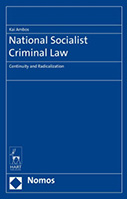National Socialist Criminal Law: Continuity And Radicalization

Author: Kai Ambos
Publisher: Baden-Baden, Germany: Nomos; Oxford, UK: Hart Publishing, 2019. 208p.
Reviewer: Brenner Fissell | February 2021
This book is an intellectual history of the German criminal law academy in the mid-20th century. Given the experience of that country during that time, though, the book’s historical claims are of great interest to even contemporary criminal theorists and to those outside of Europe.
Primarily, Ambos aims to respond to Eugenio Zaffaroni’s own recent history of Nazi criminal law theory: Doctrina Penal Nazi (Buenos Aires: Ediar, 2017). Ambos’s disagreements with Zaffaroni are ably recounted in a review by Moritz Vormbaum. Here, I will present only a brief sketch of Ambos’s history of the period, as well as my view of its implications for American criminal law theorists.
Ambos begins by explaining that the roots of Nazi criminal law can be found in 19th century German idealist theory, with the latter exploited perversely to achieve outcomes it would have expressly forbidden. While pre-Weimar writer Savigny wrote of the “spirit of the people” as justifying the liberal nulla poena principle in criminal law, Nazi thinkers such as Roland Freisler used the racist version of that spirit (volksgemeinschaft) to justify anti-liberal measures such as the “Law on the Protection of German Blood and German Honor.” Older ideas thus paved the way for a more explicit rejection of liberal criminal law by writers like Carl Schmitt. Schmitt, Ambos writes, “replace[d] the liberal concept of the [rule of law] by a National Socialist, material concept.” A “material concept of justice,” for Schmitt and others (such as Franz Gürtner), entailed re-interpreting all legal sources and concepts in light of the overarching goal of advancing National Socialist ideology. Formal constraints such as the legality principle were to be abolished, and in its place “law” became the “will” of the Führer.
This transition from a theory of a liberal, positivist rule of law to that of a totalitarian, will-based regime was effected by more than just an abstract rejection of liberalism—it was accomplished also by a systematic transformation of liberalism’s doctrinal manifestations in the conceptual architecture of criminal law.
This is most apparent in Ambos’s account of the thought of Georg Dahm and Friedrich Schaffstein, the “main representatives” of the “Kiel School,” on the role of the judge in the Nazi state. Dahm spoke of a “loosening of the ‘components of the concept of crime,’” including actus reus and mens rea, in order to “create[e] scope for ‘valuations and will-based decisions’ in more areas than just sentencing.” He later argued that the judge should focus on what Ambos calls the “substance of the offence,” and not the “rational and logical analysis of the elements.” Referring to the tatbestand (actus reus) as “artificial”—an example of “depleted and dead words,” Dahm says that “it is not the law that says what theft is,” “rather, this arises from the nature of the matter.” The “nature,” of course, means the conduct’s “significance for the völkisch order.” Thus, confiscation of a Catholic group’s flag by the Hitler Youth was no theft—despite whatever conclusion element analysis might yield. As Ambos concludes, though, “definition” of offenses by reference to this “essence” means that offenses are “actually undefined . . . thus doing away with the specificatory [sic] and limiting function of the elements of the tatbestand (actus reus).”
Ambos’s discussion of Erik Wolf’s thought (Wolf was another important Nazi theorist) is also illuminating. Wolf advocated for “replacing the three-part concept of crime by a two-part concept oriented towards the type of the act and the type of the perpetrator.” This introduction of the “perpetrator type” is of course anathema to liberal criminal law, and for Wolf the relevance of the perpetrator type was determined by reference to popular opinion and the will of the Führer. Wolf thought that acts revealed types of perpetrators who had a harmful “attitude” towards the state, and that therefore this discovery and incapacitation of those with such an attitude was the primary purpose of criminal law: “There needs to be an open catalogue of types of perpetration [tatbestandstypen],” Wolf wrote, “instead of a secret one that, as is the case today, is hidden within a catalogue of types of defined offenses.” Ambos thus identifies Wolf’s criminal law as “agent-focused.”
Overall, Ambos classifies Nazi criminal law theory as a “continuation” and also a “radicalization of existing trends” in the German academy. Founded on an ideology of antisemitic racism and Germanic nationalism, Nazi criminal thought rejected the restraints of positivism and liberalism in favor of “a complete ethicisation of (criminal) law,” with the relevant ethical principles derived from “völkisch ideals.”
National Socialist Criminal Law is a worthwhile read for any American criminal theorist—it jolts us out of our familiar discussion paradigms and reminds us of how criminal law theory was complicit in one of the darkest chapters in human history. The book’s publication is especially timely and relevant for Americans, as it comes two years after the publication of James Q. Whitman’s stunning demonstration of the connection between Southern Jim Crow policies and Nazi race laws—a connection noted by Ambos. See James Q. Whitman, Hitler’s American Model (Princeton 2017). But Ambos’s work is also relevant in the way that it bears on some contemporary debates in American criminal law scholarship.
In response to the modern crisis of racialized mass incarceration and police violence, some prominent criminal law thinkers in the United States have expressed frustration at the inability of post-World War II substantive criminal law to create a just and egalitarian system of criminal justice. Their de-emphasis of the value of criminal law, I think, should be viewed with the perspective one gains after reading Ambos’s history.
William Stuntz, for example, blamed the technical, cognitive conception of mens rea as precluding the jury from exercising moral judgment, William Stuntz, The Collapse of American Criminal Justice 194, 260 (Harvard, 2011), and Joshua Kleinfeld has made a similar argument recently, writing that older “common law mens rea standards, because of their moralistic and open-ended character, open up a necessary space for nontechnical argumentation about culpability and equity in criminal justice trials.” Joshua Kleinfeld, “Manifesto of Democratic Criminal Justice,” 111 Northwestern L.Rev. 1367, 1403 n.122 (2017).
Some positions are more extreme, and urge scholars to turn their attention away from substantive criminal law entirely—at least when considering petty offenses. Issa Kohler-Hausmann, after studying the New York City misdemeanor system, concluded that the “most important lesson” to draw is that “approaches that tinker with legal process, or even substantive criminal law reforms, are only capable of reaching a limited set of issues.” Issa Kohler-Hausmann, Managerial Justice and Mass Misdemeanors, 66 Stanford L. Rev. 611, 618 (2014). Constitutional prohibitions on vague offenses and status offenses, she writes, “do not in practice seriously constrain the power of the police and prosecutors to control people.” Issa Kohler-Hasmann, Misdemeanorland 259–60 (Princeton 2019). The central insight is that officials (especially police) can ignore the substantive law with impunity because the criminal process often does not vindicate or give effect to the offense’s definition.
The rise of mass plea bargaining has had a similar effect on even felony-level offenses, some argue, and therefore less attention to substantive criminal law is warranted across the board. Andrew Crespo, for example, cites to an overemphasis on substantive criminal law as a motivation for a new casebook he is writing with Jonathan Rappaport: “Few [criminal law professors] would defend the idea, implicit in our teaching, that the twists and turns of mens rea, actus reus, causation, justification, or excuse constitute the central features of the American penal system.”
All of these American thinkers, writing in a time of racialized mass incarceration and policing, have raised important points about the failure of substantive criminal law to prevent this tragedy. Having studied their arguments over the past few years, I too began to think that our preoccupation with substantive criminal law may be a misplaced one. Reading Ambos’s intellectual history of the Nazi criminal law theorists, therefore, felt as if it was a semaphore from the past—one that blinked a reminder.
The Nazi theorists aimed to fundamentally recast the liberal vision of substantive criminal law so as to accomplish totalitarian ends. Insistence on the legality principle, precision in doctrine, and rejection of thought and status crimes were all attacked. Schmitt called for the “material” interpretation of offenses in light of Nazi ideology, and Dahm and Wolf facilitated this doctrinally through the “loosening” of mens rea and actus reus and the introduction of the “perpetrator” and “attitude” type, respectively. Substantive criminal law as we know it, then, appeared to these thinkers as an obstacle to Nazism.
The history that Ambos chronicles serves to remind the modern American theorist of the value that substantive criminal law has—a reminder that imbues it with grandeur but also recognizes its limitations. Liberal criminal law can serve as a bulwark against many extreme and overt abuses of state power, and thus should be valued, but it cannot on its own rectify all the problems that arise when deploying a criminal justice system in the real world. We can be glad that we live in a country that does not interpret criminal offenses “materially” in light of our President’s will, but also recognize that racialized mass incarceration and social control is a grave injustice that persists. Liberal criminal law helps to prevent the former, but may be less effectual in counteracting the latter.
Brenner Fissell, Associate Professor of Law, Hofstra University


